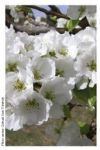|
Written by James E. Klett, PhD
|
|
Tuesday, June 11, 2019 03:00 AM |
 James E. Klett, PhD of Colorado State University (CSU) reviewed woody plants worth considering for Colorado landscapes. Here will will discuss three of his recommedations. James E. Klett, PhD of Colorado State University (CSU) reviewed woody plants worth considering for Colorado landscapes. Here will will discuss three of his recommedations.
Each year researchers at CSU evaluate over 1,300 taxa of woody plants for adaptability, flowers, fruit, pest problems and more. Students help maintain the test sites with support from Colorado Horticulture Research and Education Foundation (CHREF), J. Frank Schmidt Charitable Trust, Bailey Nursery Inc., Colorado Agriculture Experiment Station and numerous local and national nurseries. Visit these woody plants in person in Fort Collins and/or view and learn more at www.woodyplants.colostate.edu.
 Amelanchier alnifolia ‘Obelisk’ Standing Ovation™ Serviceberry (pictured right) Amelanchier alnifolia ‘Obelisk’ Standing Ovation™ Serviceberry (pictured right)
This very cold hardy plant has multiple seasons of landscape interest. White flowers in spring turn to edible berries in June, and dark green leaves turn red to orange in fall. This serviceberry has a uniform upright/oval growth habit and is a selection of our native Colorado serviceberry. Can be used to make an informal hedge/screen or use it to add height in small gardens.
Cornus mas – Cornelian Cherry Dogwood (pictured at top of page)
This plant can be grown as a shrub or small tree to about15 feet tall. It is pH adaptable and prefers a well-drained soil. Yellow flowers in March are a first-of-spring. Foliage is attractive and has prominent venation. The red fruit in August is sparsely produced due to early flowering which may be affected by spring frosts.
 Pyrus ussuriensis ‘MorDak’ PrairieGem® Ussurian Pear (pictured left) Pyrus ussuriensis ‘MorDak’ PrairieGem® Ussurian Pear (pictured left)
This very cold hardy plant—a selection from North Dakota State University —grows to about 25 feet tall and wide and is very adaptable to Colorado’s alkaline clay soils. It develops a dense, oval-to-rounded growth habit. White flowers appear before leaf emergence in April. Dark green leaves turn golden yellow in fall. Prairie Gem develops sparse fruit. This plant is a good choice under power lines or in smaller spaces
Read more in this issue of Colorado Green NOW:
Houzz report gives overview of renovation trends
Public comments open for extension of current Form I-9
ProGreen EXPO invites session topic suggestions
Selig turned a hobby into a successful niche business
|


 James E. Klett, PhD of Colorado State University (CSU) reviewed
James E. Klett, PhD of Colorado State University (CSU) reviewed Amelanchier
Amelanchier  Pyrus
Pyrus 
